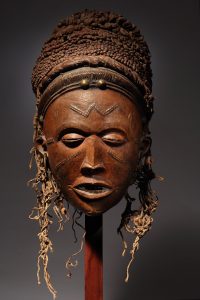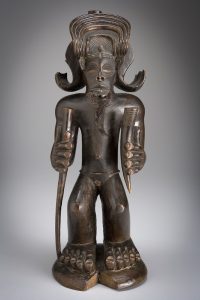The Kimbell Speaks the Language of Beauty
The Kimbell Art Museum presents the world premiere of The Language of Beauty in African Art. This remarkable exhibition of African masterpieces challenges traditional concepts of aesthetics by presenting the works of art through the perspectives and languages of the people in West, Central and Southern Africa who made and used them. With more than 200 objects from public and private collections around the world — including captivating masks, powerful figures, impressive sculptures, and exquisitely crafted prestige objects — the exhibition will be on view from April 3 through July 31, 2022.

Organized by the Art Institute of Chicago, The Language of Beauty in African Art is the Kimbell’s first major exhibition in 25 years to focus solely on works from Africa and includes three objects from the museum’s permanent collection: the Chokwe Chibinda Ilunga, the Hemba Warrior Ancestor Figure and the Ife Head, possibly a King.

Chokwe culture; Angola
Female Face Mask (Mwana Pwo or Pwo)
19th–early 20th century
Wood, pigment, metal, and fiber
Private collection
Courtesy of Schweizer Premodern, New York
“At the Kimbell Art Museum, we are committed to showcasing great works of art from around the globe, so we are pleased to work with the Art Institute and curator Constantine Petridis to present this magnificent exhibition of African art,” said Eric M. Lee, director of the Kimbell Art Museum. “What sets this exhibition apart — and why we felt it was vital to bring it to Kimbell audiences — is its focus on the ideas of the artists and communities that created the objects rather than on outside perspectives.”
The Kimbell is the only venue apart from the Art Institute of Chicago where visitors can experience this diverse grouping of objects, many of which have never been on view to the public. Following its presentation at the Kimbell, the exhibition will travel to the Art Institute of Chicago in fall 2022.
The Language of Beauty in African Art underscores how the makers’ ideas about beauty and ugliness typically extend beyond the physical appearance of objects to reveal both the meanings and the functions of these works. By learning the words that artists themselves used to describe and praise their creations — their language of beauty — visitors to the exhibition can understand these works in a new way.
“By shedding light on the highly sophisticated — yet still often overlooked — aesthetic vocabularies from different cultures across sub-Saharan Africa, we look forward to reflecting the preferences of the makers and of the cultures where the works were created,” said Constantine Petridis, Ph.D., chair and curator of the arts of Africa at the Art Institute of Chicago. “The Language of Beauty in African Art will also explore how the appearance of a work of art is an integrated combination of appearance and being, of form and meaning.”
Organized in eight sections, the exhibition focuses on masks, figures and sculptures created by cultures located primarily in West, Central and Southern Africa, most dating to the late 19th and early 20th centuries. In this vast area south of the Sahara Desert, there seem to be shared conventions that transcend the particularities of a given culture or period.

Chokwe culture; Angola
Male Figure (Identified as Chibinda Ilunga)
19th century
Wood, pigment, and fiber
Kimbell Art Museum, Fort Worth, purchase by the Kimbell Art Foundation, 1978, AP 1978.95
The exhibition begins with an examination of the interaction between art and language, featuring several examples of the widely admired art of the Chokwe people. A male figure of the culture hero Chibinda Ilunga, long lauded for its refinement and relative naturalism, perfectly embodies the Chokwe term utotombo, which describes a sculpture executed with skill and care. This idealized rendering of male power also expresses the concept of cibema, the Chokwe word for an object that combines formal beauty with moral integrity.
The next section of the exhibition looks at how, beginning in the early 1900s, Western appreciations of African art focused on the visual appearance of objects divorced from their original contexts instead of seeking and sharing knowledge about how originating cultures understood, viewed, and experienced them.
In fact, understanding this original linguistic context can shift our estimations of objects. In many African cultures, the connection between beauty and morality is expressed by a single term that combines “beautiful” with “good.” For instance, the Lega term busoga applies to what is visually pleasing as well as to praiseworthy character and virtuous behavior. Across sub-Saharan Africa, beauty and morality are linked in many ways: jewelry and other accessories are worn by men and women not only to enhance their visual beauty, but to highlight the wearer’s exceptional personality and deeds. Notions of moral and formal beauty can be embodied in venerated images of powerful men — like the Kimbell’s sculpture of a dignified male representing a Hemba warrior ancestor — or in representations of caring women, typically shown as mother-and-child figures.
A main section of the exhibition highlights the meanings and functions of the beauty of African art. African artists, patrons and critics conceive and appraise their local arts according to their own communities’ collective standards of excellence. Assessing their artist’s achievements, cultures across the sub-Saharan region apply aesthetic criteria regarding clarity or visibility achieved through stylization, abstraction, and reduction; youthfulness or the representation of the body in the prime of life; moderation (or the avoidance of exaggeration); and balance and symmetry.
 The Language of Beauty in African Art also examines how an outsider might infer local taste based on an object’s physical appearance and cultural context. For example, unusual size, complex formal features, expensive materials, and complicated techniques typically point to qualities prized by makers and patrons alike. The fact that some personal objects, such as fancy stools and headrests or figurative axes and adzes, were never actually used confirms that they primarily served aesthetic functions.
The Language of Beauty in African Art also examines how an outsider might infer local taste based on an object’s physical appearance and cultural context. For example, unusual size, complex formal features, expensive materials, and complicated techniques typically point to qualities prized by makers and patrons alike. The fact that some personal objects, such as fancy stools and headrests or figurative axes and adzes, were never actually used confirms that they primarily served aesthetic functions.
Additional themes addressed in The Language of Beauty include the religious functions of beauty demonstrated through sculptural representations of the human form meant to entice the spirits, which contrast with instances of intentional ugliness, often created to trigger reactions ranging from terror to humor. The final section of the exhibition features objects that convey ideas and feelings of force, vigor, fascination, and terror by combining beauty and ugliness in a way that makes them at once irresistibly compelling and profoundly repelling. This aesthetic inspires what the Kongo people refer to as ngitukulu, an experience of astonishment or awe.
“I am thrilled to have the opportunity to present this extraordinary exhibition at the Kimbell,” said Jennifer Casler Price, curator of Asian, African, and Ancient American art. “It not only recognizes the richness and variety of African art, it demonstrates that despite the wide cultural diversity of a vast continent, there is also unity that speaks to a shared humanity and explains why art matters. That beauty has meaning and is related to the purpose and function of the art. This is art for life’s sake.”
DATES
April 3–July 31, 2022 (Subject to change)
For more information, visit kimbellart.org/exhibition/language-beauty-african-art.


 Sign in
Sign in

